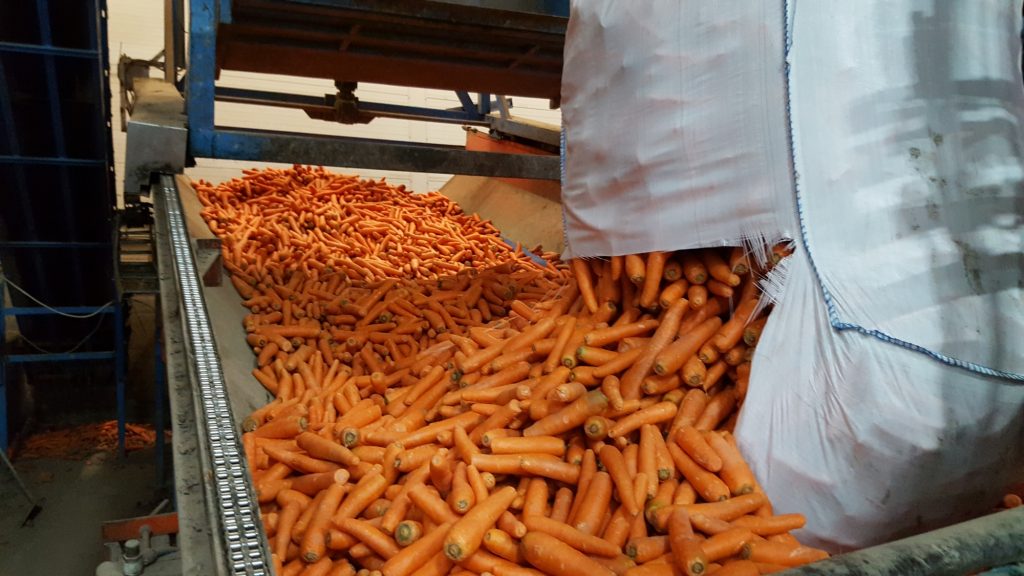
Water recycling: solution for hygiene challenges in carrot farming
The carrot sector faces a wide range of diseases that affect produce, often with serious consequences. The fungus Alternaria Dauci, for example, can wipe out 80% of a harvest. The Pythium fungus can even completely eradicate crops. Other diseases, such as Sclerotinia sclerotiorum and Rhizoctonia, cause a persistent white mouldy mycelium. These infections are not only active in the field, but also during storage, before the carrots are washed.
Why is this the case?
During the harvesting of the carrots, a relatively large amount of soil is picked up, including spores and fungi. Storage and processing under the right conditions and temperature are essential to effectively combat disease pressure. Carrots are stored almost immediately during and after washing, so that any germs present do not have a chance to develop. In an attempt to prevent problems, carrots are often transported to supermarkets as fast as possible. However, cooling carrots that have not been properly cleaned, or washing with contaminated water, are not efficient and present an opportunity for all kinds of fungi and bacteria to develop (again).
Carrots have a unique washing process
The washing process for carrots is different from that of, for example, potatoes. More water is used, partly to wash away all the clinging soil. This introduces a higher waste load and requires greater water circulation. However, if the required recirculation is carried out with conventional water basins or settling pits, these have to be relatively large. Considerable soil drainage capacity is also required. In practice, the volume of basins is often too small and insufficient suspended matter is captured. Basins and wells also quickly fill up with soil, which compromises water quality. The water wells or basins are often open, which in turn leads to physical contamination by, for example, rain, blown in dirt or vermin. In the winter period, problems with water supply caused by frost often occur.
In addition, the biological pollutant load (expressed in BOD and / or COD) in carrot washing water is higher than that associated with potatoes. Especially when the carrots are also polished with brushes in a polisher. This higher pollution load results in higher bacterial pressure in the water, which means harmful substances can build up. To counter this, aeration is required. This allows unwanted substances to be broken down and discharge requirements to be met in the areas of, for example, Organic Oxygen Demand, Nitrogen and Phosphate. The biological treatment step is more efficient when no inorganic sludge from the wash water is present in the water.
Clean washing water also ensures fewer germs on the carrots. Unfortunately, spraying with well or tap water, often the last step in the process, will not suffice – the entire process leading up to this is essential. Some sand and clay is rinsed off, but the cleanliness of the rinsing water and hygiene in the washing process leave much to be desired – while these should be among the most important aspects of the washing process.
Solutions
VAM offers a practical solution for all of these issues. With a VAM solution, washing water does not have to be replaced every time. The washing line components remain cleaner because (contaminated) soil does not accumulate or stick. That means less pollution. The VAM washing line removes inorganic sludge and can be regularly and effectively cleaned and disinfected – even daily, if necessary. What’s more, less maintenance due to wear on the rotating parts of the washing line is required.
Because the water cycle is essentially a closed circuit, hardly any water needs to be drained, or none at all. A downstream biological water treatment works more efficiently when the soil has been removed from the water. With the removal of any suspended particles, part of the BOD, N and P can also be captured. Sand and clay are removed from the water, which reduces wear on the washing installation. The separated sludge is solidified and can easily be transported back to the land. Sedimentation basins can be replaced by a treatment plant that occupies far fewer (expensive) square metres, which means that soil can be freed up, allowing for possible expansion of production.
The VAM WaterTech system makes the water suitable for reuse in the washing process and for polishing carrots. Water in cooling systems, such as a hydrocooler, stays cleaner so that produce can be cooled more efficiently, with better results. The storage time after washing is extended, which is beneficial for the continuity in the delivery of your product.
In short, with a VAM WaterTech system you are always assured of the right water quality and optimum production certainty. Millions of litres of water can also be saved in a short time, without compromising on hygiene.
Get in touch with VAM for more information or to discuss your own requirements!
Hans Blaak
phone: +31 (0) 113 – 65 58 80
email: hb@vam-watertech.com
or use our contact form.
